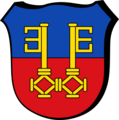Coat of arms of the city of Krefeld
|
City of Krefeld, North Rhine-Westphalia |
|
|---|---|

|
|
| Blazon | |
|
|
| City colors | |
| black gold | |
| Basic data | |
| Introduction: | 1950 |
| Legal basis: | Decision of the city council and approval of the interior minister of North Rhine-Westphalia |
| Supporting documents: | Ministerial Decree of 3 July 1950 |
The coat of arms of the city of Krefeld was approved on July 3, 1950 by ministerial decree of the state of North Rhine-Westphalia. The coat of arms is an alliance coat of arms from the city arms of the two cities of Krefeld and Uerdingen. It was designed by the heraldist Wolfgang Pagenstecher .
In Germany, the cities of Lübeck (1369) and then probably Cologne (1392) first had coats of arms . The city coat of arms often developed from the city seal or the jury seal, the coat of arms of the sovereigns or the manor. Many Rhenish towns chose the image of the patron saint of the local church as a symbol . Others took on attributes of the local or regional saint, such as Uerdingen the keys of St. Peter , the patron saint of the oldest Uerdingen church and the electorate of Cologne . The proven origin of the Uerdingen coat of arms is its large town seal from 1314, although the aldermen's seal with the image of Peter with his attribute, the two keys or only two keys have already been documented.
Krefeld, as part of the County of Moers, did not have an official coat of arms for centuries, although a layman's seal from 1463 shows Saint Dionysius , the bishop's staff in his right hand, the miter in his left and at his feet the coat of arms of the sovereign of Krefeld, the Count of Moers and become Saar . One can speak of an actual city coat of arms only since December 9th, 1854, when the Prussian King Friedrich Wilhelm IV. Granted the Lord Mayor Heinrich Ondereyck the right to wear a golden chain of office with the image of the city's patron saint . The coat of arms was based closely on the alder's seal of 1463.
This representation of the coat of arms remained authoritative until 1931. According to the contract of April 25, 1930 for the community town of Krefeld-Uerdingen on the Rhine , the coats of arms of the cities of Krefeld and Uerdingen, which stood next to one another from 1929, were combined. The new coat of arms created by Professor Hupp showed St. Dionysius, growing, with the crook in his right hand and the severed head in the left, in the upper half of the shield, the Uerdingen coat of arms with the two keys in the lower half. The coat of arms of the Counts of Moers stood, historically and therefore also heraldically incorrect, as a heart shield in the middle.
On January 22, 1938, the Upper President of the Rhine Province awarded the city of Krefeld-Uerdingen a. Rh., Which had submitted a draft by Professor Richard Schwarzkopf , a new coat of arms, which "showed the Moerser bar in the split shield in front in gold, behind the Uerdingen coat of arms in the colors blue-red with the two facing golden keys". The National Socialist city tour broke with the tradition of the Dionysius symbol and fell back into the mistake of adopting the coat of arms of the County of Moers as the Krefeld city coat of arms.
After the end of the Nazi era, a heraldically correct city coat of arms was to combine the two city coats of arms of Krefeld and Uerdingen. The city coat of arms in mixed heraldic form, approved by ministerial decree of July 3, 1950, was designed by the heraldist Wolfgang Pagenstecher . The split shield shows St. Dionysius in silver on the right with a halo and red regalia , the bishop's staff in his right, the severed head in his left, at his feet a golden shield with a black bar, on the left in blue over a red-divided field two turned away golden keys accompanied by silver shields with black bar crosses.
The severed head of St. Dionysius, who became the first bishop of the diocese of Paris in the third century and later the Frankish national saint , indicates his martyrdom. The Moers state coat of arms at his feet reminds of the earlier affiliation of the city and glory Villa Krefeld to the county of Moers. The shields of the Electorate of Cologne in the coat of arms of Uerdingen indicate the sovereignty of the Elector of Cologne over the city of Uerdingen and at the same time symbolize the affiliation of some parts of the old office of Linn-Uerdingen to today's urban area.
Coat of arms of the city of Krefeld-Uerdingen a. Rh. Based on a design by the heraldist Otto Hupp from 1931
Current coat of arms of the city of Krefeld based on the design of the heraldist Wolfgang Pagenstecher
Simplified coat of arms (utility coat of arms) of the city of Krefeld based on the design of the graphic artist Theo Windges
Web links
See also
swell
- Guido Rotthoff (editor): Document book of the city and the office of Uerdingen , Verl. D. Uerd. Heimatb., Krefeld 1968.
- City of Krefeld, Mayor's Office, Council and Representation Department (authors Dr. Guido Rotthoff and Ernst Köppen)
- § 2 of the main statute of the city of Krefeld from March 5, 2012, printed in the Krefeld Official Gazette 67th year No. 11 from March 15, 2012
Individual evidence
- ↑ Guido Rotthoff (editor): Document book of the city and the office of Uerdingen , Verl. D. Uerd. Heimatb., Krefeld 1968.





